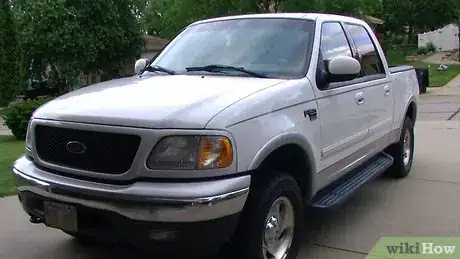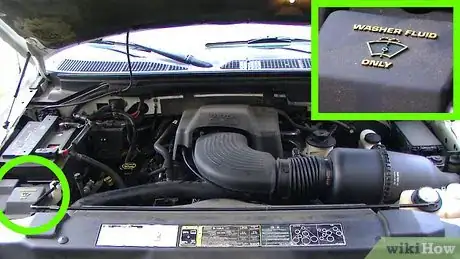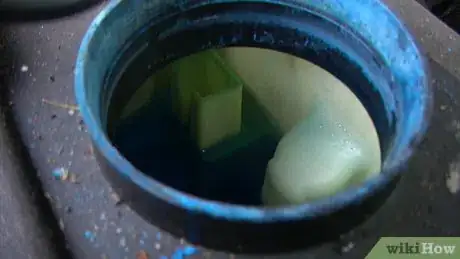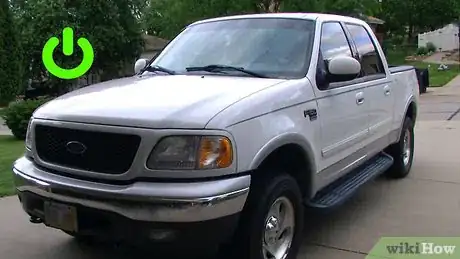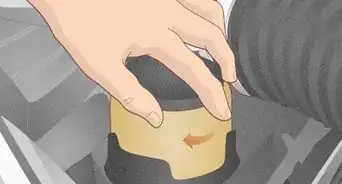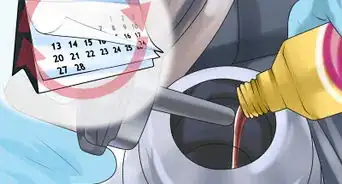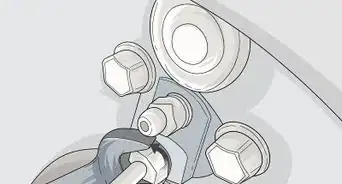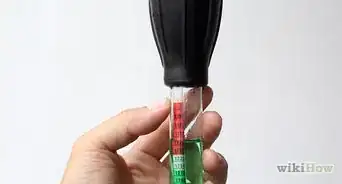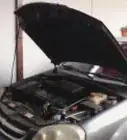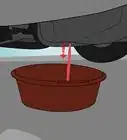X
wikiHow is a “wiki,” similar to Wikipedia, which means that many of our articles are co-written by multiple authors. To create this article, volunteer authors worked to edit and improve it over time.
This article has been viewed 89,069 times.
Learn more...
Windshield wiper fluid, or windshield washer fluid, helps your windshield wipers remove dirt and grime from the windshield. Mostly water, washer fluid usually includes ammonia to enhance its cleaning ability, alcohol to prevent streaking and to keep ice from forming in the washer nozzles. When driving under dusty or slushy conditions, you may have to use your wipers frequently, making it necessary to check the windshield wiper fluid level.
Steps
-
1Park your car. Ideally, you should do so on a level surface to help the engine bay cool. Wait for a few minutes, until the car hood is cool enough to rest your hand on.[1]
-
2Open the hood.[2]Advertisement
-
3Look for the washer fluid reservoir. On most cars, the washer fluid reservoir is located at the back of the engine bay, near the base of the windshield. The tank is usually translucent, allowing you to see whether there is fluid in the reservoir or not.
-
4Check the wiper fluid level. Many washer fluid reservoirs have marks to show the fluid level. If the tank is less than half-full, you'll need to refill it.[3]
- Also, check the tank for cracks or leaks.
-
5Uncap the washer fluid reservoir. The reservoir cap usually is designed to screw on and off.
-
6Add washer fluid until the reservoir fluid level reaches the "full" mark. You may want to use a funnel to avoid spills. Once you've refilled the tank, replace the cap and close the hood.[4]
-
7Turn the car key to the "on" or "accessory" position. This will let you test the washers' performance by turning on your windshield wipers and then the washers. The washers should deliver a steady stream of fluid; if not, you may have to clean the washer nozzles and lines.
Advertisement
Community Q&A
-
QuestionI filled the reservoir with fluid and the fluid does not come out when I push on the control. What could be the problem?
 Community AnswerYou have to make sure you don't introduce dirt into the system because it can create a clog. It might be a bad pump.
Community AnswerYou have to make sure you don't introduce dirt into the system because it can create a clog. It might be a bad pump. -
QuestionMy car produces a whistling sound when accelerating, what might be the cause?
 Community AnswerIt could be anything, such as air flow, a loose seal around a door, mechanical resonance, or the brakes. If you slightly apply the brakes, does the sound go away, or does it get worse? Some cars make whistling sounds normally. Sometimes there is a leak at the air cleaner. Some cars make a high frequency sound at around 65 miles per hour because the mechanical resonance was designed to be optimized for freeway speeds. The torque converter can slip rather than engage the engine directly. In that event, the RPMs will be higher than normal and the gas mileage will be lower than normal. Maybe the wheel bearings need to be checked.
Community AnswerIt could be anything, such as air flow, a loose seal around a door, mechanical resonance, or the brakes. If you slightly apply the brakes, does the sound go away, or does it get worse? Some cars make whistling sounds normally. Sometimes there is a leak at the air cleaner. Some cars make a high frequency sound at around 65 miles per hour because the mechanical resonance was designed to be optimized for freeway speeds. The torque converter can slip rather than engage the engine directly. In that event, the RPMs will be higher than normal and the gas mileage will be lower than normal. Maybe the wheel bearings need to be checked. -
QuestionMy fuel gauge suddenly stop working. A couple of days later when I filled up, it moved up and down several times, and has stayed down since. What might the problem be?
 Community AnswerIt's probably your fuel pump. There is a Bowie that floats to see how much gas you have.
Community AnswerIt's probably your fuel pump. There is a Bowie that floats to see how much gas you have.
Advertisement
Warnings
- Keep washer fluid out of the reach of pets and small children, particularly if it contains antifreeze. Most antifreeze is made with ethylene glycol, which tastes sweet but is poisonous.⧼thumbs_response⧽
Advertisement
Things You'll Need
- Bottle of washer fluid
- Funnel (optional)
- Rag or paper towel (to wipe up spills)
References
- ↑ https://www.youtube.com/watch?v=oxwnPBnVcX0
- ↑ https://www.youtube.com/watch?v=f_Nd7UDOmr8
- ↑ https://www.youtube.com/watch?v=t45UzxSCuNY
- ↑ https://www.youtube.com/watch?v=Zei_WDRA0XM
- http://www.motorward.com/2009/10/how-to-check-your-windshield-washer-fluid-level/
- https://www.dummies.com/home-garden/car-repair/maintaining-your-wipers-and-washer-fluid/
About This Article
Advertisement
